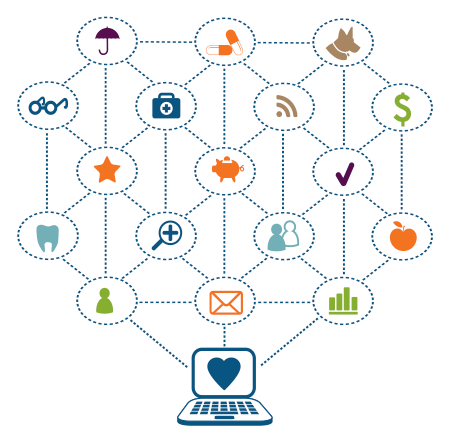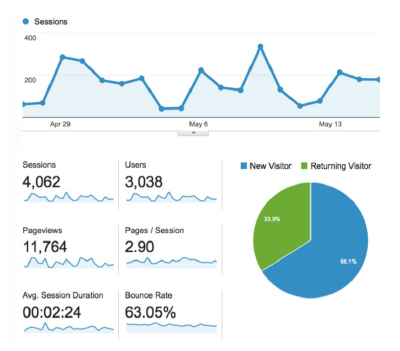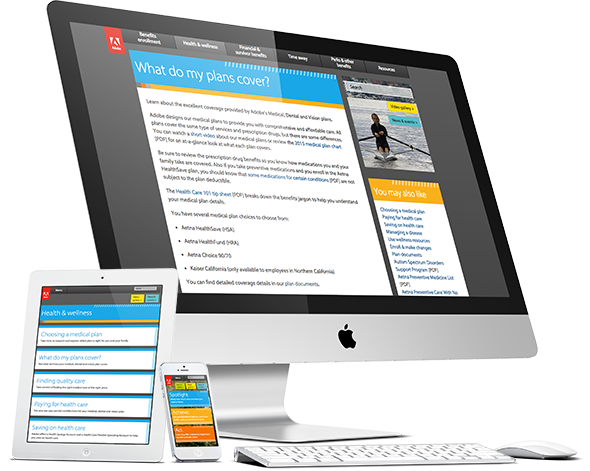
The Benefits of a Benefits Website: 12 Questions We Hear the Most
Employee benefits account for a chunk of expenses that's significant enough to raise the question, “How is your company ensuring that your employees are understanding, appreciating, and using the full range of benefits available to them?” Smart companies are treating employees like consumers and health care like a product, and in turn are creating employee benefits websites that strategically market their benefits offerings. Read on for answers to the top 12 questions we hear about benefits websites.
1. What’s the advantage of having a benefits website versus just having a benefits administration system that provides benefits content? 
If you had one benefits administrator who touched all your programs and had rich, easy-to-understand content for every single program you offer, you would have no need for a separate benefits website. But most organizations have many administrators. So employees end up having to go to one place for health and well-being benefits, another place for retirement, another place for their stock purchase plan, and another system altogether to request a leave of absence. You might have a whole set of work-life benefits that are provided by one-off vendors, or a robust wellness program that has a whole administration platform of its own.
Moreover, many administrators put content behind very complex logins—as they should—because they’re dealing with personal data. But that discourages employees from going to those sites on a regular basis or accessing basic benefits info. And spouses often don’t have access to all the administrators’ websites. Or, if they do, it’s a clunky experience that involves logging in as the employee.
Employees and spouses need help navigating the complex benefits maze. When you build your site, be sure to look at the whole ecosystem, with all the places people need to go for information. When you address annual enrollment, wellness, or the 401(k) on your benefits website, steer people to the administrator of those benefits so they can make those transactions. It’s all about creating a more cohesive experience and organizing benefits content, programs, and plans in ways that make sense to your employees.
Although administrators are starting to build robust, user-friendly websites, you don’t have control over how frequently they update their information. And the sites typically offer limited opportunity for branding, apart from, “your logo goes here.” When you want to get information out and market your programs, having your own channel is a huge benefit.
2. How can I convince my company to invest in a benefits website?
A benefits website is absolutely the best investment you can make in your benefits department. It’s an infrastructure investment that will pay for itself over several years. Instead of looking at communications as an additional line item to reduce, companies should be looking at strategic communication channels as an investment. You’re spending a huge amount of money on all your benefits plans—and by extension on your employees. The right communications can ensure that those benefits are being used and valued. A benefits website costs virtually nothing compared to your total health care spend. You just need to look at the money you’re spending on communications through a different lens. Ask yourself questions such as, “What are the costs of employees not enrolling in the right plans?” or “Are your employees fully taking advantage of all of the programs you offer?”
3. How much does it cost to create a benefits website?
That’s kind of like asking, “What does it cost to go on vacation?” or “What does it cost to build a house?” It depends on whether you want to be budget conscious or go all out and stay at the Four Seasons. Do you want to live in a tiny cottage or a huge palace?
You can create a very simple micro-site with just a few pages all by yourself. You can build it almost for free and pay very little for hosting. Or you can build a very robust, comprehensive website that has all the bells and whistles, such as videos and interactive content, which will cost more.
If you have fewer than 1,000 employees, talk to your consultants and see what resources they might have available. Or see what you can do yourself or with internal resources. If you have more than 5,000 employees, make a significant investment in your website and use an external firm to build something that’s really robust and meaningful for your employees. If you’re a midsize company (1,000–5,000 employees), it may be tough to justify the investment. Still, many organizations of this size see the value in investing in a benefits website because it’s the best way to educate employees about their programs and motivate them to take action.
4. What’s the overall process for creating an external website?
There are many ways to build an external website. Your IT or marketing department may have the internal resources to build an external site that's outside of your firewall. Or your company may have a partnership with a web development firm that builds websites for your company all the time. Or, you might want to work with an outside firm that specializes in building websites.
Often, the simplest approach is to hire an outside firm to build and manage the site. The firm will coordinate with your IT department to make sure it’s following IT standards, and keep your IT people involved in the process. The outside firm will also coordinate with your internal communications and corporate communications departments to make sure they’re on board with this new resource for employees and their family members. The firm will typically handle the information architecture, design, and web development, and work with a hosting provider.
You can find a million shops that will build a website, but not many of them have the expertise of building HR/Benefits websites. To be successful, you need the technical know-how plus the subject matter content expertise. That is the winning formula!
Several smaller, boutique firms, such as Benz Communications, develop custom benefits websites, as do many of the large HR consulting firms that have communications practices. Occasionally, your internal teams, such as your IT or marketing department, can develop a website for you. But keep in mind that those internal teams often don’t have the necessary resources, or you might have to wait a long time depending on your internal team’s competing priorities.
5. Are there risks involved in having benefits information outside my company’s firewall?
There is still a big misconception about what kind of information should be available on a company’s benefits website. A lot of people think that their company’s general benefits information needs to be protected. But any information that you would use to educate employees about your benefits programs should be housed outside your company’s firewall. It doesn’t need to be password protected, since it’s not confidential information.
We live in the information age—employees, new hires, and managers expect information to be available when and where they want it. Removing barriers to information is one of the most important things you can do to help increase employee engagement with your benefits. Of course, all information related to personal transactions and personal data should be kept on the administrators’ password-protected websites. And some organizations might want to keep certain information off the benefits website—such as sensitive information about specific employee populations (like executives) or detailed policies around leaves of absence—but at least 95% of your benefits information should be housed outside the firewall.
6. Which web traffic metrics will help me assess the effectiveness of my company’s benefits website?
When you’re assessing the effectiveness of your communications and your website, here are some key questions to keep in mind:
- Does overall website traffic increase after you send out a communication?
- Which website pages are most viewed?
- Which pages do employees use to enter and exit the site? (This can help you see trends in what they’re looking for and where they’re getting frustrated or confused.)
- How much time do they spend on the overall site? On specific pages? (This can help you see what employees are most interested in.)
- Which pages have the highest ratings or what are employees saying about specific pages (write-in comments)?
- What topics are people searching on?
- Where are people accessing the site from (your corporate network, at home, on mobile phones)?
7. When deciding what to put on our website, should I be more concerned with satisfying the employees or keeping the benefits specialists and/or legal department happy?
To build a better website and more effective communications campaigns, focus on the users. But don’t forget that while you’re keeping your employees engaged and informed, you also need to pay attention to compliance requirements. Of course, compliance and benefit communications are two separate things. The less you intermingle the two, the better.
8. How often should my company post blogs to communicate about benefits?
It all depends on what your team can manage, and your communication strategy. If you’re using a blog on your own benefits website, posting a new blog two to three times a month is usually enough to keep your website fresh and keep employees updated on your benefits programs. If that’s too much for your team to keep up with, try a more modest publishing schedule throughout the year, and then post more frequently during the more active times, such as annual enrollment.
9. Are online channels appropriate for communicating any benefits-related topic?
Yes. Whether you’re communicating about health care, retirement, wellness, or work-life benefits, online channels can help you quickly get important messages out to your employees. A lot of companies have been focusing more on health care and wellness programs because that’s where all the changes are, and they’ve been neglecting important topics like retirement and financial security. By using online channels, you can take a more holistic approach to make sure all benefits topics are getting covered.
10. Is there a way to make certain information accessible only to certain employee populations on a benefits website?
The idea that you can keep certain benefits information away from certain populations is outdated. The reality is that anyone can get their hands on another group’s benefits guide. In a day and age when anyone can take a photo or a screen capture of a website and then post it or send it wherever they want, we have to admit we can’t control everything.
You should put as much information as possible on your benefits website. If you absolutely need to differentiate by populations, there are ways to do that from a technological standpoint, such as housing certain information behind logins or allowing users to self-identify and choose their own path to get to the content that is most relevant to them. We see that often with international content, where an Australian employee would be able to toggle views to see U.S. benefits and vice versa. Many organizations have found that their concerns about secrecy were overblown, especially when they’ve discovered the value in making important benefits information accessible to all employees.
11. What is the best way to communicate information from all of my different carriers and vendors?
All your carriers have their own brands. If they’re communicating directly to your employees, you’re losing out on a valuable branding opportunity. This is one of the main reasons that it’s so important for you to have control over your own resources.
The best way to manage an environment with multiple administrators is to consolidate and brand all of the information on your website and then push employees to the vendor sites when they need to take action, such as changing their 401(k) elections or updating beneficiaries.
A lot of organizations—especially smaller ones—can benefit from co-branding or repurposing the materials that their carriers and vendors provide. You don’t have to reinvent the wheel. Use what your carriers are providing when it’s valuable, but brand it or co-brand it so employees know that you’re the ones who are providing that program or benefit.
12. What are some of the emerging benefits communication approaches that employers are using to engage employees?
The baseline is to have a responsive website that's available outside of the firewall, that looks great on mobile devices, and that's a high-quality user experience. You also need to be getting employees information when they need it throughout the year—via email, postcards mailed to their homes, text messages, etc.
Once you’ve established that as your foundation for communication, the next stage is to consider targeting and segmentation. Communications are most effective when they’re very focused messages that help nudge employees into taking the next step, making better decisions, or making better use of your plans and tools. It’s about personalizing the messages to make them more accessible, engaging, relevant, and meaningful.
Along those lines, you may want to enhance your website so that it’s more of a consumer experience, with videos and interactive content like you’d find on a consumer website. Also consider organizing content around user goals and objectives, and always remember: It isn’t about your plan or program; it is about helping your employees lead better lives!
We’re also really excited about one of the next evolutions in HR and benefits communications—personalized mobile apps that focus on aggregating personal data and leveraging technology to push targeted communication and alerts to employees.
Watch our Master Class! 
In our webinar, Likes, Tweets and Clicks: The Do’s and Don’ts of Online Communication, we delve into the rules of engagement for communicating on the web, including:
- How to navigate social media—it’s not as complicated as you might think.
- Effectively addressing legal, privacy, and security concerns.
- Adapting communication for mobile users.
Work with Us
We partner with organizations that value their people first. Let’s talk.

Jon Stuckey, VP Creative Technology and Innovation, provides strategic vision, guidance, and solutions for our largest clients.
